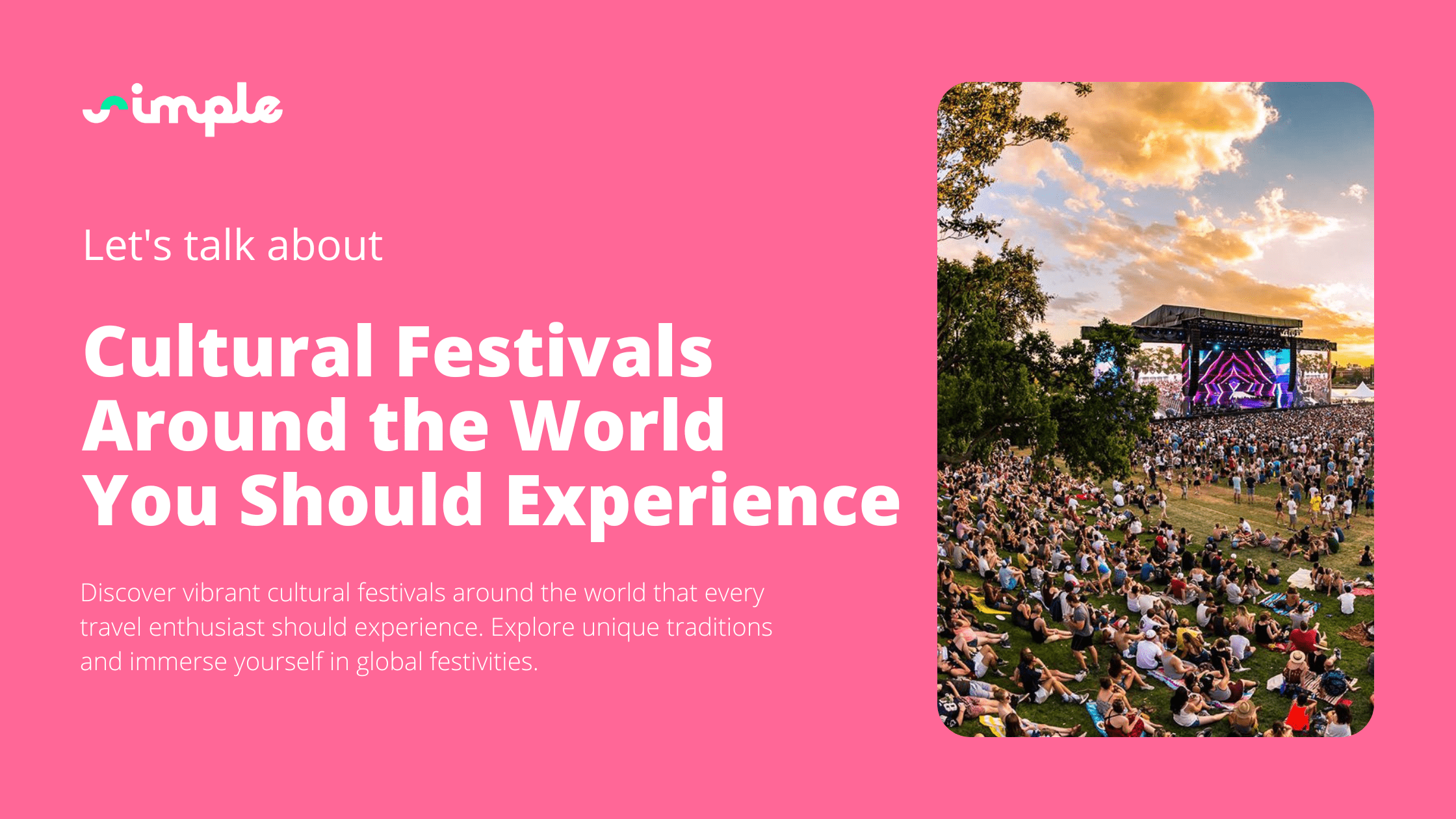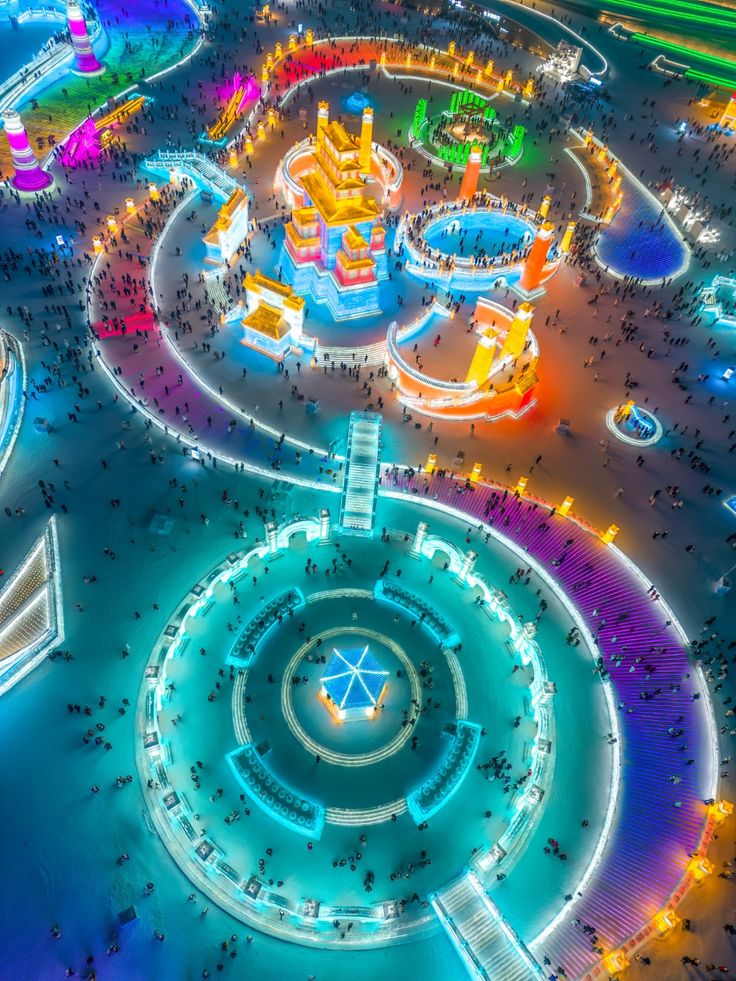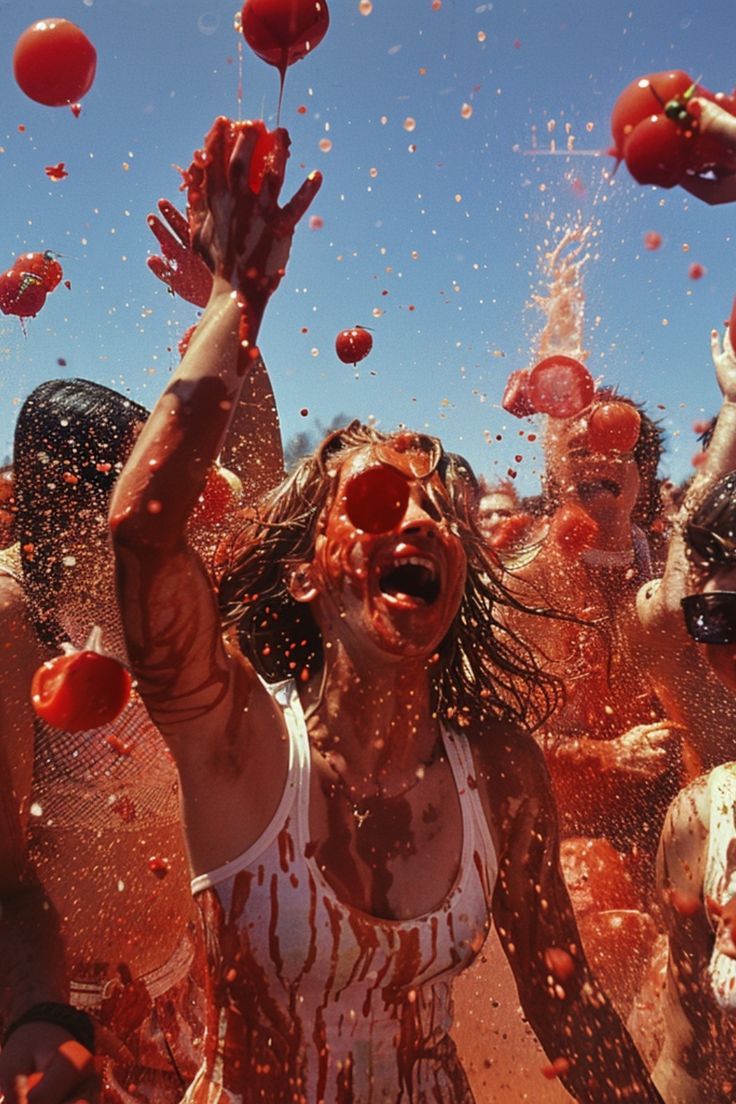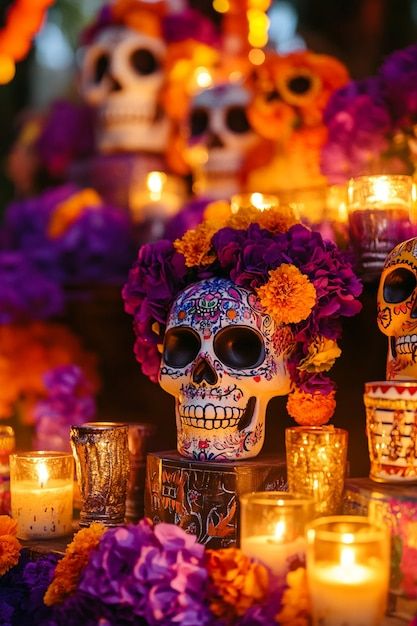Cultural Festivals Around the World You Should Experience

Cultural festivals serve as vibrant expressions of a community’s heritage, offering a unique opportunity to bridge cultural gaps and foster global understanding. These events are not just celebrations; they are immersive experiences that allow travelers to engage deeply with the traditions, music, art, and cuisine of different cultures. From the colorful parades of Rio Carnival in Brazil to the serene rituals of Japan’s Cherry Blossom Festival, each festival provides a window into the soul of a nation. For those with a passion for travel, attending these festivals can be a transformative experience, enriching their understanding of the world and its diverse cultures. The array of cultural festivals across the globe is as diverse as the cultures they represent, each offering its own unique charm and insights. Whether you’re drawn to the rhythmic beats of African drums or the intricate dances of Indian festivals, there’s a cultural celebration waiting to captivate your senses and broaden your horizons.
Festivals in Asia
Diwali in India

Diwali, also known as the Festival of Lights, is one of the most significant cultural experiences in India, celebrated with great enthusiasm and joy. This festival symbolizes the victory of light over darkness and good over evil, and it is observed by millions of people across the country. The significance of Diwali lies in its rich history and the various legends associated with it, including the return of Lord Rama to Ayodhya after defeating the demon king Ravana. During this time, homes and streets are adorned with vibrant lights, oil lamps, and colorful rangoli designs, creating a mesmerizing spectacle.
Key activities and rituals during Diwali include the lighting of diyas (oil lamps), bursting of fireworks, and the exchange of sweets and gifts among family and friends. The festival is also marked by special prayers and offerings to deities, particularly Goddess Lakshmi, the goddess of wealth and prosperity. Travelers visiting India during Diwali can immerse themselves in the festive spirit by participating in local celebrations, enjoying traditional Indian cuisine, and witnessing the grandeur of temple rituals. Cities like Jaipur, Varanasi, and Amritsar are renowned for their spectacular Diwali festivities, offering a unique blend of cultural heritage and modern celebrations.
Chinese New Year in China
The Chinese New Year, also known as the Spring Festival, is the most important traditional festival in China, celebrated with a series of cultural traditions and festivities. This festival marks the beginning of the lunar new year and is a time for family reunions, feasting, and honoring ancestors. The celebrations last for 15 days, culminating in the Lantern Festival, where colorful lanterns light up the night sky. Each year is associated with one of the 12 animals in the Chinese zodiac, adding a unique cultural dimension to the festivities.
Cultural traditions during the Chinese New Year include the giving of red envelopes (hongbao) filled with money, which symbolizes good luck and prosperity. Families gather for a reunion dinner on New Year’s Eve, featuring a lavish spread of traditional dishes such as dumplings, fish, and rice cakes. Travelers can experience the vibrant atmosphere of the Chinese New Year by visiting destinations known for their spectacular festivities, such as Beijing, Shanghai, and Guangzhou. These cities host grand parades, dragon and lion dances, and stunning fireworks displays, offering a captivating glimpse into China’s rich cultural heritage.
Harbin Ice Festival in China

The Harbin Ice Festival, held annually in the city of Harbin in northeastern China, is the world’s largest ice and snow festival, attracting visitors from around the globe. This unique festival showcases an incredible array of ice and snow sculptures, ranging from intricate carvings of mythical creatures to life-sized replicas of famous landmarks. The festival typically runs from early January to late February, transforming Harbin into a winter wonderland of dazzling lights and frozen artistry.
One of the unique features of the Harbin Ice Festival is the use of multicolored lights embedded within the ice sculptures, creating a magical and ethereal ambiance. Travelers can explore the festival’s various zones, including the Ice and Snow World, Sun Island International Snow Sculpture Art Expo, and the Zhaolin Park Ice Lantern Fair. Each zone offers a distinct experience, from ice slides and snow mazes to ice skating and sledding. For those seeking adventure tourism, the festival also offers activities such as ice climbing and winter swimming in the Songhua River. The Harbin Ice Festival is a must-visit travel destination for those looking to experience the beauty and creativity of winter art on a grand scale.
Festivals in Europe
Oktoberfest in Germany
Oktoberfest, held annually in Munich, Germany, is the world’s largest beer festival and a cornerstone of Bavarian culture. This iconic event traces its origins back to 1810, when it was first celebrated to honor the marriage of Crown Prince Ludwig to Princess Therese of Saxe-Hildburghausen. Over the years, Oktoberfest has evolved into a global phenomenon, attracting millions of visitors who come to enjoy the rich traditions and vibrant atmosphere. The festival is a celebration of beer culture, with numerous breweries showcasing their finest brews in massive beer tents, each offering a unique experience.
While beer is undoubtedly the star of Oktoberfest, the festival offers a wide array of events and attractions that appeal to a diverse audience. Visitors can enjoy traditional Bavarian music, dance performances, and parades featuring horse-drawn carriages and people in traditional costumes. The festival grounds, known as the Theresienwiese, also host a variety of amusement rides, games, and food stalls offering delicious Bavarian cuisine. For those interested in cultural experiences, Oktoberfest provides a unique opportunity to immerse oneself in Bavarian traditions and hospitality. Travelers planning to attend should consider travel insurance and travel safety tips to ensure a worry-free experience.
La Tomatina in Spain

La Tomatina, held in the town of Buñol, Spain, is a unique and exhilarating festival known for its massive tomato fight. This quirky event originated in 1945, when a group of young people engaged in a spontaneous food fight during a local parade. Over the years, La Tomatina has grown into a globally recognized festival, drawing thousands of participants eager to engage in the messy yet thrilling tradition. The festival takes place on the last Wednesday of August, transforming the streets of Buñol into a sea of red as participants hurl overripe tomatoes at each other.
Participating in La Tomatina requires some preparation and adherence to safety guidelines. Participants are advised to wear old clothes and protective eyewear, as the tomato pulp can be quite acidic. It’s also important to follow the festival’s rules, such as squashing tomatoes before throwing them to prevent injuries. For those planning to join the fun, budget travel tips can help make the experience more affordable, while travel accommodations in nearby Valencia offer convenient access to the festival. La Tomatina is not just about the tomato fight; it also includes a week-long celebration featuring music, parades, and fireworks, providing a well-rounded cultural experience.
Carnival of Venice in Italy
The Carnival of Venice is a captivating festival renowned for its elaborate masks, opulent costumes, and enchanting masquerade balls. This historic event dates back to the 12th century and has become a symbol of Venetian culture and artistry. Held annually in the weeks leading up to Lent, the Carnival of Venice attracts visitors from around the world who come to witness the city’s transformation into a magical realm of mystery and elegance. The allure of the carnival lies in its ability to transport participants to a bygone era, where they can indulge in the fantasy and glamour of Venetian traditions.
One of the highlights of the Carnival of Venice is the array of masquerade balls held in historic palaces and venues throughout the city. These exclusive events offer a glimpse into the opulence of Venetian society, with guests donning intricate masks and period costumes. The festival also features a variety of public events, including parades, street performances, and contests for the best mask and costume. For those interested in travel photography, the carnival provides a stunning backdrop of canals, gondolas, and historic architecture, making it a dream destination for capturing unforgettable moments. The Carnival of Venice is a celebration of art, history, and culture, offering a unique travel itinerary for those seeking an immersive cultural experience.
Festivals in the Americas

Day of the Dead in Mexico
The Day of the Dead, or Día de los Muertos, is a deeply meaningful and colorful celebration observed throughout Mexico. This unique festival honors deceased loved ones, celebrating their lives and welcoming their spirits back to the world of the living. The Day of the Dead is celebrated on November 1st and 2nd, coinciding with the Catholic holidays of All Saints’ Day and All Souls’ Day. The festival’s roots can be traced back to ancient indigenous traditions, and it has since become a symbol of Mexican cultural identity.
The celebration of the Day of the Dead is marked by vibrant altars, or ofrendas, adorned with photographs, marigolds, candles, and offerings of food and drink. Families gather to remember and honor their ancestors, sharing stories and memories while enjoying traditional foods such as pan de muerto (bread of the dead) and sugar skulls. Regional variations of the festival can be found throughout Mexico, each offering unique ceremonies and customs. In Oaxaca, for example, the festival is characterized by elaborate parades and street performances, while in Michoacán, the island of Janitzio hosts a stunning candlelit procession on Lake Pátzcuaro. Travelers seeking cultural experiences can explore these regional variations, gaining insight into the rich tapestry of Mexican traditions and beliefs.
Rio Carnival in Brazil
The Rio Carnival in Brazil is one of the most famous and vibrant festivals in the world, drawing millions of visitors to the city of Rio de Janeiro each year. Known for its dazzling parades, elaborate costumes, and infectious samba rhythms, the carnival is a celebration of life, culture, and community. The origins of Rio Carnival date back to the 18th century, and it has since evolved into a global spectacle that showcases the rich cultural heritage of Brazil. The festival typically takes place in the days leading up to Lent, offering a final burst of exuberance before the solemnity of the Lenten season.
At the heart of Rio Carnival is the samba, a lively and rhythmic dance that embodies the spirit of Brazilian culture. The highlight of the festival is the Samba Parade, where samba schools from across the city compete in a dazzling display of music, dance, and creativity. Each school presents a themed performance, complete with intricate floats and costumes, captivating audiences with their artistry and passion. Beyond the parades, Rio Carnival offers a plethora of events and activities, from street parties and live music performances to cultural workshops and culinary experiences. For those planning to attend, travel itineraries can be tailored to include both the main events and off-the-beaten-path cultural experiences, ensuring a memorable and immersive adventure tourism experience.

Inti Raymi in Peru
Inti Raymi, the Festival of the Sun, is a vibrant and historically significant celebration held in Cusco, Peru. This ancient Incan festival honors Inti, the sun god, and marks the winter solstice in the Southern Hemisphere. Inti Raymi was originally celebrated by the Inca Empire as a way to express gratitude to the sun for its life-giving energy and to ensure a bountiful harvest. Today, the festival has been revived as a cultural event, attracting visitors from around the world who come to witness the grandeur of Incan traditions.
The main events of Inti Raymi take place on June 24th, beginning with a reenactment of the ancient ceremonies at the Qorikancha, the Temple of the Sun, in Cusco. The celebration then moves to the Sacsayhuamán fortress, where a grand spectacle unfolds, featuring traditional music, dance, and elaborate costumes. The festival is a powerful expression of Incan heritage, offering a unique opportunity for travelers to connect with Peru’s rich history and cultural legacy. For those planning to attend, travel accommodations in Cusco provide convenient access to the festivities, while eco-friendly travel options allow visitors to explore the region’s stunning landscapes and archaeological sites. Inti Raymi is a celebration of life, culture, and the enduring spirit of the Incan people, making it a must-see event for those seeking an authentic and immersive cultural experience.
Streamlining Your Travel: The Importance of an eVisa for Visiting Iconic Destinations
SimpleVisa: Your Trusted Partner for Fast and Easy eVisa Applications
For those planning to visit these incredible destinations, it’s important to ensure your travel documents are in order. Many countries now require an eVisa for entry, which simplifies the process and saves time. Services like SimpleVisa offer a user-friendly platform that makes obtaining an eVisa fast and hassle-free. With just a few easy steps, SimpleVisa ensures your application is processed smoothly, saving you time and effort so you can focus on the unforgettable experiences that await you at these remarkable sites.
Conclusion
Cultural festivals play a pivotal role in enriching travel experiences by offering profound insights into the traditions and values of communities around the world. These vibrant celebrations are more than just events; they are living expressions of cultural heritage that invite travelers to step beyond the ordinary and immerse themselves in the extraordinary. Whether it’s the rhythmic samba of Rio Carnival, the solemn yet joyful remembrance of the Day of the Dead, or the historical reenactments of Inti Raymi, each festival provides a unique lens through which to view the world. By participating in these festivals, travelers gain a deeper understanding of the cultural narratives that shape societies, fostering a sense of global interconnectedness and appreciation for diversity.
For those with a passion for exploration, cultural festivals offer an unparalleled opportunity to connect with different cultures and create unforgettable memories. These events encourage travelers to step out of their comfort zones and engage with the world in meaningful ways, whether through dance, music, art, or shared traditions. By attending festivals, travelers can forge connections with locals, learn about historical and contemporary cultural practices, and experience the joy of communal celebration. As you plan your next adventure, consider incorporating cultural festivals into your travel itineraries. Not only will you enrich your journey with unique cultural experiences, but you’ll also contribute to the preservation and appreciation of global traditions. Embrace the opportunity to witness the world through the eyes of its diverse cultures, and let these festivals inspire your travels and broaden your horizons.